
CentSai prides itself on writing independent reviews. Check out our rubric to see the objective standards we use.
Highest Possible Total Score:
Among the more fascinating changes over this past year were the ways in which everyday folks took to social media to discuss investing.
It feels as though, almost overnight, thousands of users started flocking to online communities like Reddit’s r/WallStreetBets, Facebook groups, and Twitter for hot stock tips; hashbragging about their portfolio going #ToTheMoon; or entering any number of virtual Clubhouse chat rooms for strategic discussions about the best way to invest their stimulus.
With this newfound popularity of online stock trading applications and platforms, and their intersection with social media, it was really only a matter of time before a platform like Public emerged.
Public is a commission-free investing platform-cum–social feed that consolidates the purchase of shares in publicly traded companies with the discussion surrounding investments into a single app, available for both Apple and Android phones.
From a singular platform, users can purchase fractional or whole shares of popular stocks while firing off tweet-like thoughts on their investments, tagging other users to provide insights based on their own experience, or hop in on other users’ conversations.
It’s a novel idea for an app that essentially exists albeit in separate parts — most investors keep their social media feeds and investment applications separate.
Public hopes that in creating a social community around investing, users of all experience levels can rely on other users’ conversations to “build your financial literacy within a transparent community” and “follow other investors [as well as] share insights with people from different professional backgrounds.”
Here’s how Public stacks up based on the experience of a new user and an investor with intermediate experience.
 Ease of Use Score:3
Ease of Use Score:3
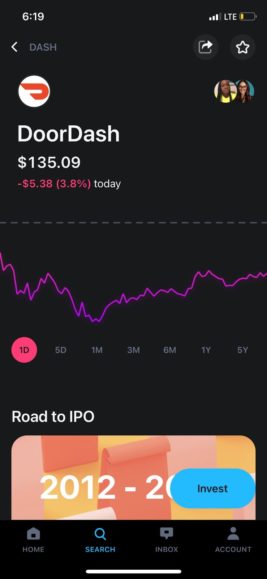
Public provides a user-friendly experience, one that makes both interacting with other budding investors as well as purchasing shares simple.
When it comes to investing, users can search for stocks and exchange-traded funds (ETFs) by name or ticker. Once an asset is selected, you can see its price change over time, in intervals ranging from the last 24 hours to the last five years.
You’re also presented with a feed that shows recent news stories — aggregated from sites such as Market Watch, CNBC, CNN, and financial newswires — related to the stock, its quarterly performance, statistics (such as market capitalization and volume), as well as analyst ratings of whether to buy or sell.
It might sound like a lot of info all at once, but the user interface is clean and easily digestible, making learning about and/or buying different stocks a cinch.
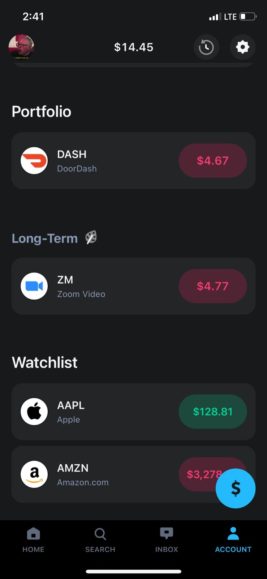
Public acts as an intermediary when it comes to purchasing stocks — you add funds to your in-app balance from your bank account or debit card, and then use the money deposited to buy stocks.
I loaded up my account with $10, and purchased $5 worth of DoorDash to assuage my own guilt of indulging in too much takeout over the past week. After I hit confirm, my order was filled within a few seconds.
Once you’ve purchased a stock or ETF and it is added to your account, you can drag it between two sections: portfolio and long-term.
Stocks will be added by default to the portfolio section, but you can move them to long-term if you want to categorize your assets by how long you intend to hold them.
It’s not a super fleshed-out component of the platform, but it’s nice to have some organizational features at the investor’s disposal, even if it’s just separating them into categories.
There is a third category called watchlist for stocks investors are weighing an initial or additional investment in, as well. So if you’re a bit short on cash (or hesitant to put more skin in the game), you can add stocks to that section and easily view their performance over time.
The only potential downside I could see to Public’s investing component is that the company is very much against the use of its platform for day-trading (speculative investment wherein an investor purchases and sells an asset typically within the same trading day with the intention of realizing a profit).
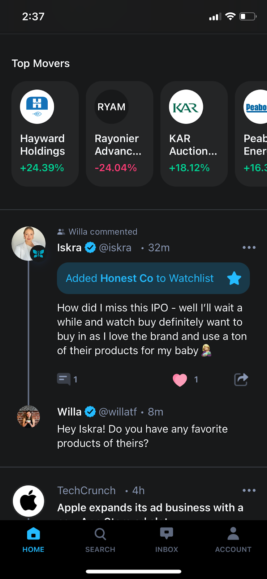
Users can day-trade on occasion, but if Public observes a pattern of day-trading behavior it will issue three warnings before suspending your account. This policy won’t affect everyone, but it’s certainly a restriction to usability that potential users should be aware of before signing up.
Public’s social features help to further the discussions of hot tickers in the market.
Each stock purchase is shared on the app’s main timeline (alongside text about the purchase, if the user wants to share some thoughts on their recent acquisition); users can see which stocks other investors have within their portfolio (as well as how much of each) in addition to their long-term and watchlist sections.
Each purchase of a stock or ETF being shared to your feed, however, might make more private investors a bit wary to sign up.
Users can also engage in conversations about investing by commenting on others’ posts, or connecting via direct message — similarly, as I’ve said before, to the types of functions you’d find on Twitter.
It’s important to note that though Public hopes having a timeline in-app will further financial literacy, the opinions added by its users on why they choose to purchase a certain stock or ETF is by no means expert-vetted.
Crowdsourcing information and having an aggregate of news stories available about a public company can help you make an informed decision about whether or not to buy, but investors should use their own judgement (or that of a trusted friend or financial professional) to determine what’s best for their portfolio.
In terms of usability, digital natives and other individuals who have spent a fair amount of time online will feel comfortable with Public’s main feed. The timeline is sleekly designed and easily scrollable, which paired with the ease of use that comes with investing, makes the core dual functions of Public a win-win.
 Bang for Your Buck Score:4
Bang for Your Buck Score:4
Like many investing applications, Public is free to join and offers the incentive of free stock at sign up. It’s able to maintain its status as a free platform primarily through venture backing, interest accumulated on uninvested user cash balances, as well as a few other paid financial services.
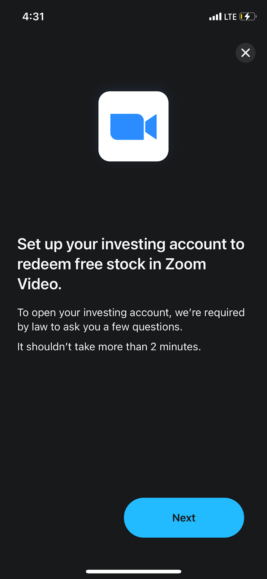
To begin, I simply provided some personal information to verify my age and prove I live in the United States, and described my investing experience (intermediate).
Within a few hours, my account was approved and I received $5 worth of stock in Zoom — a company most of us are likely well acquainted with at this point.
Your free fractional share might be a different amount (up to $20), as the amount designated for this sign-up offer is random, according to Public’s website. Users get to choose which company’s stock they obtain from a pre-selected list of a couple dozen.
One thing that new investors will definitely find enticing (especially those who may still be a bit reticent to pony up their own money) is that Public does not require a minimum deposit for its free stock, a qualifying factor for some other app-based investment platforms. Just sign up, choose your “free” stock, and you’re good to go.
Given that Public provides up-to-the-minute updates on the trading price of stocks, commission-free trading on shares and ETFs, and the ability to join with no money down, it’s easy for new investors to get started with very little money (the smallest amount of stock you can purchase at a time is $5 worth).
Individuals interested in additional financial services such as broker phone trades, wire transfers, paper statements, and stopping a check will have to pay an additional fee per service per use, however, ranging from $30 to $75.
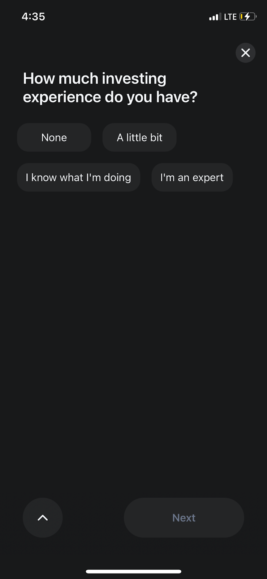
Pair that with the capacity to read up on new developments and observations from other investors, and Public feels a cut above other investment applications I’ve used — though it is just a bit disappointing that Public offers only ETFs and stocks without the option to invest in other assets like cryptocurrency.
Rather than reading about new movements in the stock market on Twitter (or worse, falling victim to the infinite scroll), I’ve got a consolidated timeline of users posting solely about their investments and/or prospective purchases.
Consolidating both investment discussion and application into one app prevents the necessity of switching between separate platforms. It may not seem like a huge plus, but it’s most certainly appreciated by millennial or Gen Z investors who are easily distracted.
Public is a member firm of the Securities Investor Protection Corporation (SIPC). Assets held at SIPC member firms are protected, up to a maximum of $500,000, in the event the member firm fails and has to be liquidated.
 Customer Service Score:1
Customer Service Score:1
Public offers an in-app chat feature, a wide-spanning FAQ page, as well as a contact email.
With no phone number and somewhat long wait times for a response (when requesting to talk to a person on the app, the company informs you that they “typically reply in a day,” and it took about an hour and a half for someone to respond to my question via app and email), it can feel frustrating for users who want to speak with a real person to resolve an issue.
Though the app’s FAQ page is comprehensive and offers responses to most user inquiries, given that Public is an investing app, one would imagine its response times would be quicker to assuage customer concerns.
Users are rightfully concerned about accessing their portfolio at their leisure, so in the event of a technical hiccup, the onus is on the platform to respond in a time-sensitive manner.
Public’s lack of a timely response time to several inquiries (both on the app and by email) could leave skittish investors with a bad taste in their mouth — and it appears to be the only real downside of using this application.
 Reputation
Reputation


Public is accredited by the Better Business Bureau and holds an A+ rating, with customer reviews totalling 4 out of 5 stars for 16 reviews. Of the five complaints lodged against the company over the past year (all of which had to do with either delays in certifying the user’s banking information, or problems with app usability), all five were resolved.
 Public has high ratings in the App Store, boasting a rating of 4.7/5 based on 12,000 reviews, and a 4.4/5 on Google Play based on 8,000 reviews. Most positive reviews tend to express satisfaction with Public’s social features, with average or negative reviews venting frustration about the aforementioned difficulty experienced when trying to connect with a real person.
Public has high ratings in the App Store, boasting a rating of 4.7/5 based on 12,000 reviews, and a 4.4/5 on Google Play based on 8,000 reviews. Most positive reviews tend to express satisfaction with Public’s social features, with average or negative reviews venting frustration about the aforementioned difficulty experienced when trying to connect with a real person.
 The Bottom Line
The Bottom Line

For the first-time investor — as well as investors who want to both talk the talk and walk the walk in the same place — Public offers a unique, friendly experience, letting users view public comments on stock performance (and the latest news on publicly traded companies), as well as invest in them, within a single platform.
Though there are a few restrictions to how its user base invests (by limiting day-trading), and despite the fact the site somewhat leaves users to their own devices when they want to troubleshoot errors, Public’s two-in-one functionality, ease of use, and affordability make it easy to get started on your investing journey.
At the same time, the app provides access to a robust community of like-minded investors dedicated to growing their personal wealth.
If you’re looking for an unrestricted online brokerage, or if you don’t care for community discussion on recent stock performances, then this likely isn’t the app for you. But for those who want to share their thoughts on new market developments while acquiring assets, Public might be just the place to put your bottom dollar.
Past performance is not a predictor of future results. Individual investment results may vary. All investing involves risk of loss.









